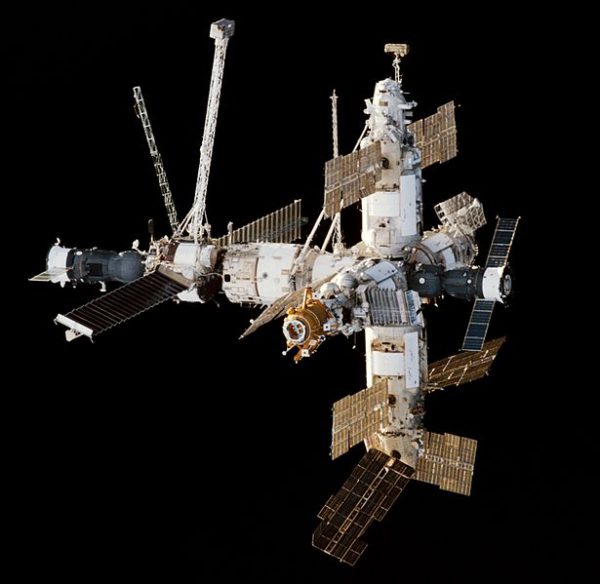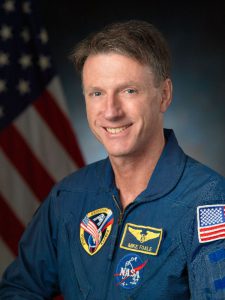We all know mathematicians are the coolest people on the planet. But it turns out that of all the people not on the planet, all of them are in fact either mathematicians, or have mathematical backgrounds or training. Astronauts – and Russian cosmonauts – are all super mathsy people, and if they weren’t already awesome enough, this really seals the deal for me.

There are two main routes to becoming an astronaut – you’ll either start by being a test pilot, in which case you’ll train to fly experimental aeroplanes; in that case, before you start, you’ll need a degree in a science-related subject (maths, physics, biology or engineering) plus three years experience building on that (usually in research); so, the equivalent of a PhD. You’ll also need to be between 64 and 76 inches tall (I am in fact 64.9 inches, so it’s good to know I’d have had the option). The other way to become an astronaut is as a payload specialist, which means you’re a scientist going up to run or oversee a scientific experiment – again, you’ll need to be a research scientist and hence a pretty capable mathematician.
It’s obvious that there’s plenty of maths involved in space exploration – from calculating the physics of trajectories and launch escape velocities, to fuel quantities, and then once in space, maintaining all the systems needed to move things, sustain life support and generally keep things going. You might argue that most of the mathematics here can be done by ground crews, and to a large extent that’s true – but in space, and especially in emergency situations, the astronauts themselves sometimes have to pitch in and crack on with the sums.
One famous example of this was in 1997, when a team aboard the Russian space station Mir (pictured above – ‘mir’ in Russian means ‘peace‘, or with a capital M ‘world‘, but it’s also used to mean a community or village, aww) found themselves in exactly such an emergency situation – while testing a new manual docking system for one of the incoming Progress modules, used to deliver goods and equipment to the station, there was an accident and the Progress module collided with part of the station, causing an air leak and damage to the Mir solar panels.
After scrambling to seal off the decompressed section of the station, and restoring a balance of air pressure, the crew found themselves in a bit of a spin – quite literally. The station had been knocked out of its usual stable orientation by the collision, and the gyrodynes, or momentum storage devices, usually used to keep the station correctly oriented in orbit, were unable to keep it pointing in the right direction. This was a bit of a problem – the astronauts themselves didn’t mind too much, since they’re in zero gravity and don’t know which way is up anyway – but the station’s solar panel array, used to power all the systems on board, was no longer pointing at the sun.
The station lost power, and the backup batteries were soon exhausted. This meant the gyrodynes also powered down, leaving the station entirely without power, and rotating even more without the stabilising effect of the momentum storage devices.
This left the crew on board in a bit of a bind – without power, they could only maintain sporadic contact with the ground. Under normal circumstances, communication was only possible when the station’s orbit took it within range of one of the base stations on earth, but now they could only speak for a short time, and then only every few hours. The crew, which included two Russians and a British NASA astronaut called Michael Foale, needed to get on with some maths.

Michael Foale
Foale realised they could use the station’s Soyuz module (Russian for ‘union’), which was the Russian equivalent of the space shuttle – it was used to fly up to the station, and remained docked to the back of Mir in case they needed to evacuate. While the station was powered down, Soyuz still had onboard thrusters and could in theory be used to manoeuvre the station so it was pointing at the sun again. While the ground crew tried to assist with calculations, they didn’t have enough information or telemetry to be able to send any useful suggestions.
Yes, they apparently carried a scale model of Mir on the space station Mir. Which hopefully itself had a tiny tiny model of Mir inside that, and so on.
Setting up a crude mock-up of the scenario – mounting a torch on the ceiling, shining down on a scale model of Mir held over a table representing the surface of the Earth, Foale and his colleagues modelled the motion of the spinning station. By holding his thumb up to the window, he could use the speed at which stars passed behind it to calculate roughly the speed and direction they were spinning in. They also had to work out the orientation of the Soyuz relative to the rest of the station, and what direction the thrusters would move them in when fired.
The problem was made more complicated by the fact that the actual moment of inertia of the station will depend on the distribution of mass within the different sections, which it’s impossible to know as things might have been moved around – they could only base their calculations on the positions of fixed hardware. On top of this, the point the Soyuz was mounted at meant they could only really use it to rotate in two of the three axes, as it wouldn’t have any control around the axis it was pointing in the direction of.
After a lot of scribbling and working out, and communicating with the ground crew when possible, Foale used Euler’s equations, some rotation matrices, and a few simultaneous equations to calculate that a 3-second burn on one side of the Soyuz would get them stabilised and stop them spinning. They tried it, and it worked! Maths in space success! Especially impressive to do maths while the room you’re in is spinning (as anyone who’s got a wheely chair in their office and has tried to do maths while rotating will know).
It did take a long time for them to recover fully from the incident – as well as recharging the station’s batteries, and getting all the systems back online (including the gyrodynes), they also had to fix the puncture – a hole only 3cm across – and repressurise the damaged section of the station, which took months of work. It included a difficult internal ‘space walk’ – unlike previous crews, whose space walks all took place on the outside of the station, they had to squeeze into the damaged part of the station wearing a full space suit in order to locate and patch the hole.
While waiting for the depressurised section to be fixed, Foale wondered if it’d be possible to do the mathematical calculations more rigorously – if anything similar happened again, it’d be useful maths to have. He wanted to use his favourite maths software, Mathematica, to model the spinning station. However, his laptop and Mathematica CD were both in the Spektr module – the part of the station that had been damaged. He also couldn’t get to any of his personal effects, clothes or toothpaste, but this was more important. So, he got on the phone. The space-phone.
Wolfram Research, who make Mathematica, were more than happy to oblige – he literally called Wolfram Tech Support from space, and asked them to send him another copy. They put a new hard drive containing all the right software onto the next Progress module being sent to the station, and within a couple of weeks he was back in business. (It’s a good job really, as when they did retrieve his belongings from Spektr, his laptop had not survived being exposed to the cold vacuum of space. If anyone’s wondering, it was an IBM ThinkPad.) Michael’s Mathematica notebook, detailing the calculations he did, and including 3D animated models of Mir, is available online for anyone who’s got Mathematica to play with.
Further reading
Mir Spacecraft: Worst collision in the history of space flight – BBC Witness
Astronaut Places a Customer Service Call to Wolfram Research from Space Station Mir, on the Wolfram Blog
Michael Foale, on Wikipedia
It is a great pleasure for me, as a Russian person, to read something about Russia or Russian-related things in Western press, which doesn’t include words like “Stalin”, “GULAG” or “Putin did it again”. It’s really pleasing that you mentioned in your article that Russian astronauts are calling themselves “cosmonauts” (Yeah! Because Cosmos!). So, thank you!
However, I feel, that I should inform you about some little inaccuracy in that article. You wrote, “‘mir’ is Russian for a community or village”. I really don’t want to upset you, but that’s quite not correct. The word “Mir” if it starts with capital “M”, stand for “World”, or “Universe” in Russian. But if it starts with lower case “m”, then it stands for “peace”.
Thanks for your comment, and I’m glad you enjoyed the article. I’ve updated that sentence now to correct my error – not sure where I read that translation but it looks like it’s a word with many meanings. Thanks!